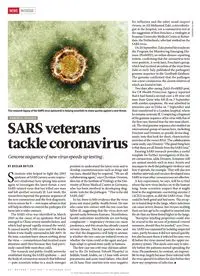Table Of ContentBY DECLAN BUTLER
S
cientists who helped to fight the 2003
epidemic of SARS (severe acute respira-
tory syndrome) have sprung into action
again to investigate the latest threat: a new
SARS-related virus that has killed one man
and left another seriously ill. Last week, the
researchers reported the genome sequence of
the new coronavirus and the first diagnostic
tests to screen for it — two major advances that
will help in efforts to control the pathogen if it
turns into a wider menace.
The SARS virus was identified in March
2003 as the cause of an epidemic that had
emerged in China several months before, and
which had spread rapidly around the world.
It caused nearly 8,500 cases and 916 deaths
before it was finally contained in July 2003. At
the time, scientists knew almost nothing about
the virus — coronaviruses had received scant
attention until then because they had previ-
ously caused little more than colds.
The research and public-health networks
established during the SARS epidemic — and
the body of coronavirus research that followed
— puts scientists today in a much stronger
position to understand the latest virus and to
develop countermeasures such as drugs and
vaccines, should they be required. “We are all
collaborating again,” says Christian Drosten,
director of the Institute of Virology at the Uni-
versity of Bonn Medical Centre in Germany,
who has been involved in developing diag-
nostic tests for the pathogen. “This is the old
SARS club.”
So far, there is little evidence that the virus
poses any major public-health threat. No one
who came into contact with the two cases has
fallen ill, suggesting that the virus does not
spread easily between humans. Nonetheless,
health authorities worldwide are not being
complacent — respiratory viruses can cause
pandemics, and this strain has already caused
serious disease. The key question now, and
one that the diagnostics will help to answer,
is whether the two cases are isolated events or
whether the virus could strike again and per-
haps adapt to spread more easily in humans.
The first case was a 60-year-old man admit-
ted to the Dr Soliman Fakeeh Hospital in
Jeddah, Saudi Arabia, on 13 June with severe
pneumonia and acute renal failure, who died
on 24 June. Post-mortem tests were negative
for influenza and the other usual suspect
viruses, so Ali Mohamed Zaki, a microbiolo-
gist at the hospital, ran a coronavirus test at
the suggestion of Ron Fouchier, a virologist at
Erasmus University Medical Centre in Rotter-
dam, the Netherlands, who had worked on the
SARS virus.
On 20 September, Zaki posted his results on
the Program for Monitoring Emerging Dis-
eases (ProMED), an online disease-reporting
system, confirming that the coronavirus tests
were positive. A week later, Fouchier’s group,
which had received an isolate of the virus from
Zaki in early July, published the pathogen’s
genome sequence in the GenBank database.
The genome confirmed that the pathogen
was a new coronavirus, the closest relatives of
which are found in bats.
Two days after seeing Zaki’s ProMED post,
the UK Health Protection Agency reported
that it had found a second case: a 49-year-old
man from Qatar who fell ill on 3 September
with similar symptoms. He was admitted to
intensive care in Doha on 7 September and
then transferred to a London hospital, where
he remains seriously ill. Comparing a fragment
of the genome sequence of his virus with that of
the first case showed that the two were identi-
cal. The viral genome sequence also enabled an
international group of researchers, including
Fouchier and Drosten, to quickly devise diag-
nostic tests that look for short, characteristic
stretches of the virus’s RNA. The collaboration
came easily, says Drosten: “The good thing here
is that these are all friends from the SARS time.”
Existing SARS research provides a useful
template for further investigation of this lat-
est coronavirus, adds Drosten. Scientists will
use animal models such as mice, ferrets and
macaques to study the pathogen’s virulence and
how it spreads, for example. They will also test
whether antivirals and vaccines developed since
SARS to treat other coronaviruses are effective.
A key experiment, he says, will be to find
where the new virus latches on to the human
lung. Some scientists suspect that it might
bind to the angiotensin-converting enzyme 2
(ACE2) receptor, as did the SARS virus. That
could be both good and bad news. The recep-
tor is found deep in the lungs, where infections
can cause severe disease, but viruses nestling
there are less apt to be coughed or sneezed into
the air than are those found higher in the lungs.
“Receptor-binding properties could also
be crucial to the success of potential control
measures, should they be needed,” says Dros-
ten. SARS was contained by isolating suspected
cases, partly because it did not spread quickly,
but also because those it infected became very
ill before the virus moved into the upper res-
piratory system. That made cases easy to iden-
tify before the patients started spreading the
virus. Flu pandemics, by contrast, are impossi-
ble to stop, largely because those infected with
the virus spread it to others for days before they
show any symptoms of infection. ■
BIOMEDICAL RESEARCH
SARS veterans
tackle coronavirus
Genome sequence of new virus speeds up testing.
The research legacy of the SARS virus (pictured) is helping scientists to move quickly against a new threat.
COURTESY OF HPA
2 0 | N A T U R E | V O L 4 9 0 | 4 O C T O B E R 2 0 1 2
IN FOCUS
NEWS
© 2012 Macmillan Publishers Limited. All rights reserved

